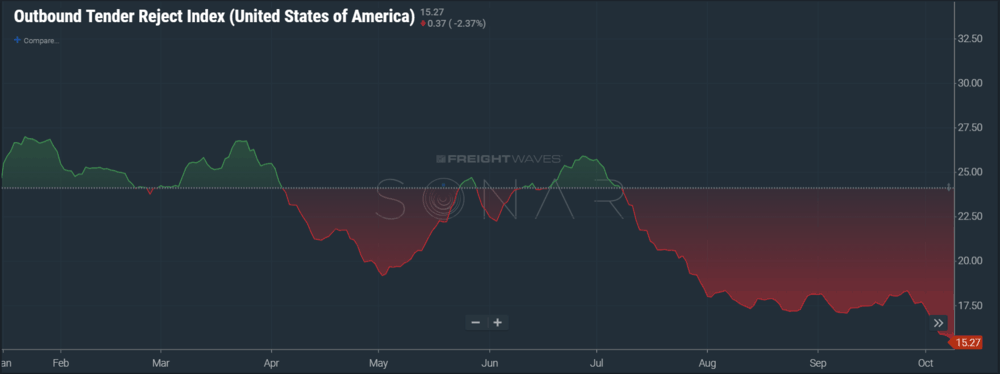The Dow Jones Industrial Average plummeted today, posting its biggest loss since May 29; meanwhile the S&P 500 is on a losing streak that hasn’t been matched in upwards of 2 years. According to Dow Theory, transportation stocks are traditionally a leading indicator of industrial sector health—as well as the direction stocks may be headed. Using Barchart’s Freight Market Center as well as FreightWaves SONAR, FreightWaves assessed the way the Dow’s 500-point loss is being felt in the broader freight market ahead of expected losses in The Dow Jones Industrial Average.
As seen in the graph of the Dow Jones Transportations index above, transport equities took a nosedive today, following a downward trend that began mid-September. Stocks across modes of transportation took hits, impacting companies involved in rail, air, and maritime freight markets. From LTLs to 3PLs, companies with exposure to trucking weren’t safe from the drop either.
Old Dominion (NASDAQ: ODFL), which Stifel’s (NASDAQ: SF) David Ross refers to as “the fastest-growing and most profitable LTL carrier” over the past decade decade, saw a change of -4.21% during today’s trading, the second largest drop among LTLs. In the truckload sector, Covenant Transportation (NASDAQ: CVTI), USA Truck (NASDAQ: USAK), and Daseke, Inc. (NASDAQ: DSKE) felt the biggest losses, dropping 4.3%, 2.95%, and 2.61% respectively.
A similar downward trajectory is evident in our Outbound Tender Reject Index (OTRI.USA), which has generally decreased since July. Tender Reject Indices are measurements of carriers’ willingness to accept the loads that are tendered to them by shippers under contract terms. It is expressed as a percentage of loads rejected to total loads tendered.

According to FreightWaves’ Senior Market Analyst Zach Strickland, the most recent national OTRI value is a new annual low. Rejection rates had fallen from summer highs close to 26% in late June to 17.31% in early August where values hovered until the end of September. Since October 1st Tender rejection rates have fallen every day.
Tender rejection rates are a measurement of carrier sentiment, which is a combination of available capacity and attitude toward their contracted rates. When carriers reject loads more frequently it means that capacity is limited and the freight market is heating. Conversely, when tender rejections decline, it means capacity is available and the market is softening.
Outside of tender rejections, freight markets continue to show signs of weakening as the outbound tender volume index (OTVI) for the U.S. has fallen 3.3% over the past seven days. The tender volume index is a measure of overall truckload movement in the U.S. and is based on a March 1st value with a base of 10,000. Currently the value is 9,403, indicating 5.97% fewer loads in the system than on March 1st of this year.
These simultaneous drops can be interpreted according to the Dow Theory, which posits that the Dow Transportation Average is closely tied to the Dow Industrial Average, “predicated on the idea that in an economy, transports deliver what industrial companies produce, and so one index will move in tandem with the other,” as explained by CNBC. With this in mind, an overall decline in Industrials reflects the losses felt earlier this summer, finally catching up to volatility within the Dow Transportation index.
